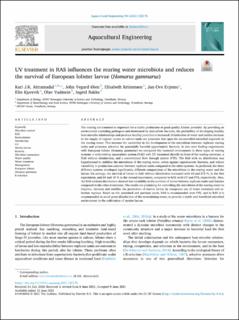| dc.description.abstract | The rearing environment is important for a stable production of good quality lobster juveniles. By providing an environment excluding pathogens and dominated by mutualistic bacteria, the probability of developing healthy host-microbe relationships and produce healthy juveniles is increased. Disinfection of water and sudden increase in the supply of organic matter in culture tanks are processes that open for uncontrolled microbial regrowth in the rearing water. This increase the variability in the development of the microbiota between replicate rearing tanks and promotes selection for potentially harmful opportunistic bacteria. In two start feeding experiments with European lobster (Homarus gammarus) we compared the bacterial environment in three types of rearing systems: a recirculating aquaculture system (RAS) with UV treatment directly in front of the rearing raceways, a RAS without disinfection, and a conventional flow through system (FTS). The RAS with no disinfection was hypothesised to stabilise the microbiota of the rearing water, select against opportunistic bacteria, and reduce variability in production outcome between replicate tanks compared to the other systems. As predicted, the three different systems developed significantly different compositions of the microbiota in the rearing water and the larvae. On average, the survival of larvae in RAS without disinfection increased with 43 and 275 %, in the first experiment, and 64 and 18 % in the second experiment, compared to RAS with UV and FTS, respectively. Also, the RAS without disinfection showed less variability in the survival of larvae between replicate tanks and batches compared to the other treatments. The results are promising for controlling the microbiota of the rearing water to improve, increase and stabilise the production of marine larvae by competent use of water treatment and selection regimes. Based on the presented and previous work, RAS is recommended over FTS, and in RAS it is recommended to avoid point-disinfection of the recirculating water, to provide a stable and beneficial microbial environment in the cultivation of marine larvae. | en_US |

